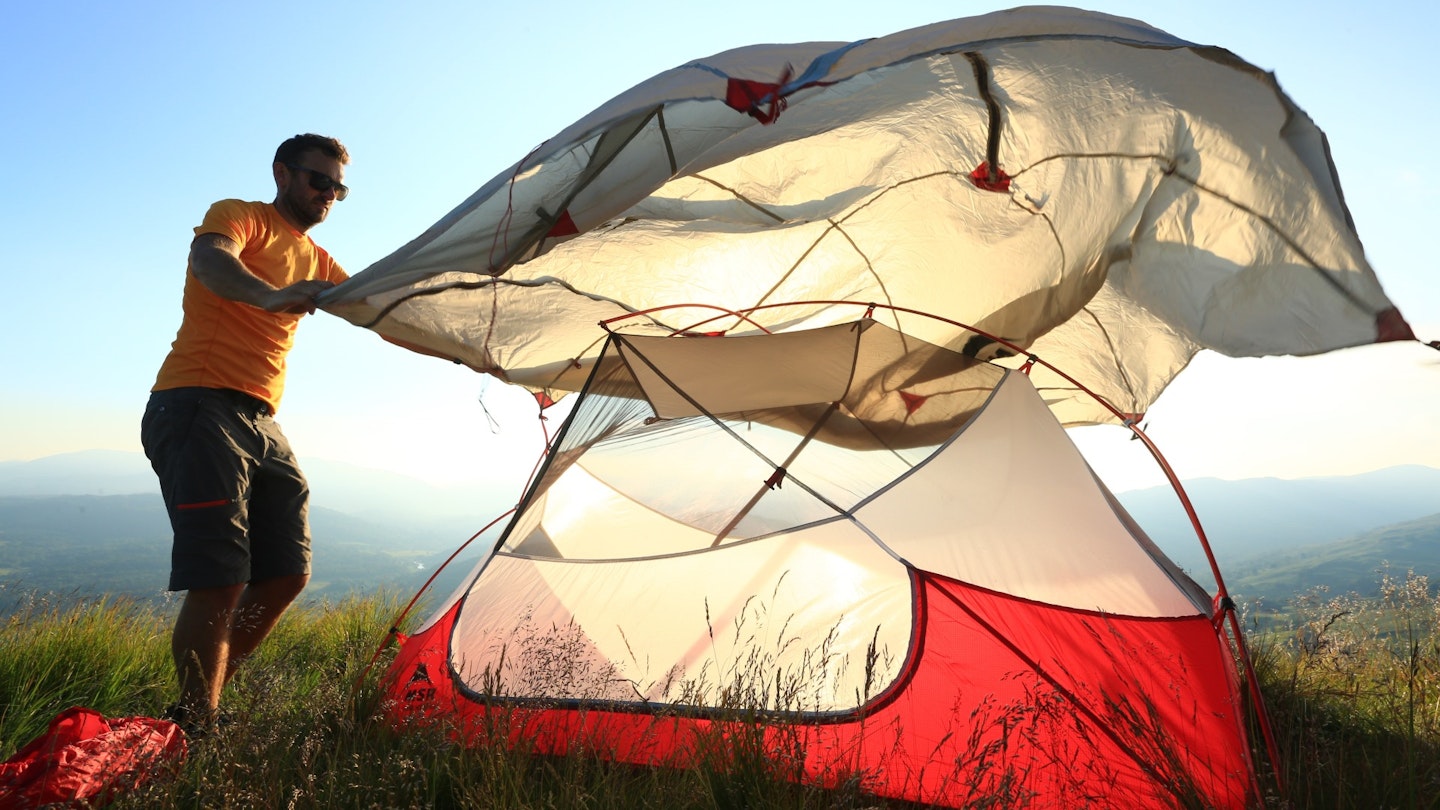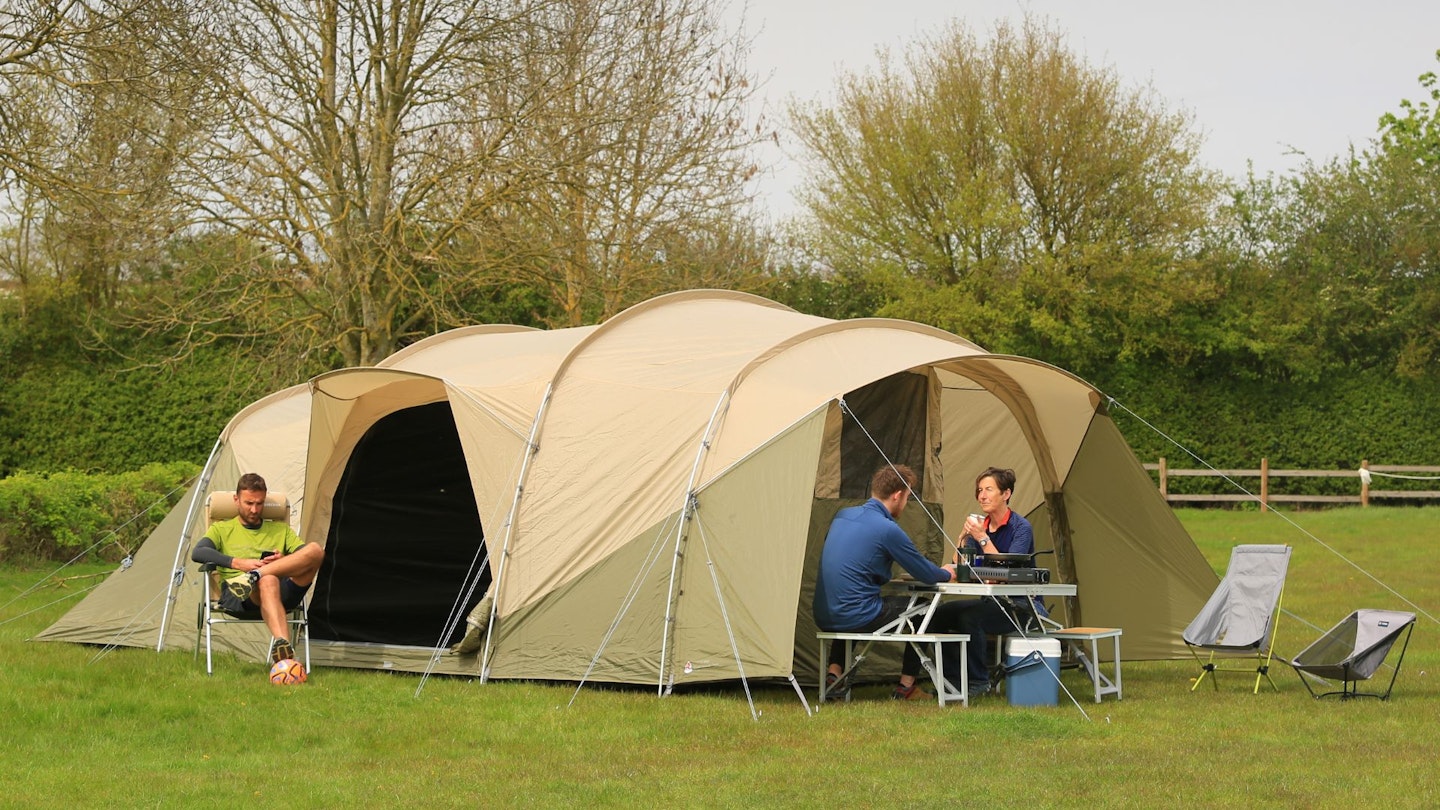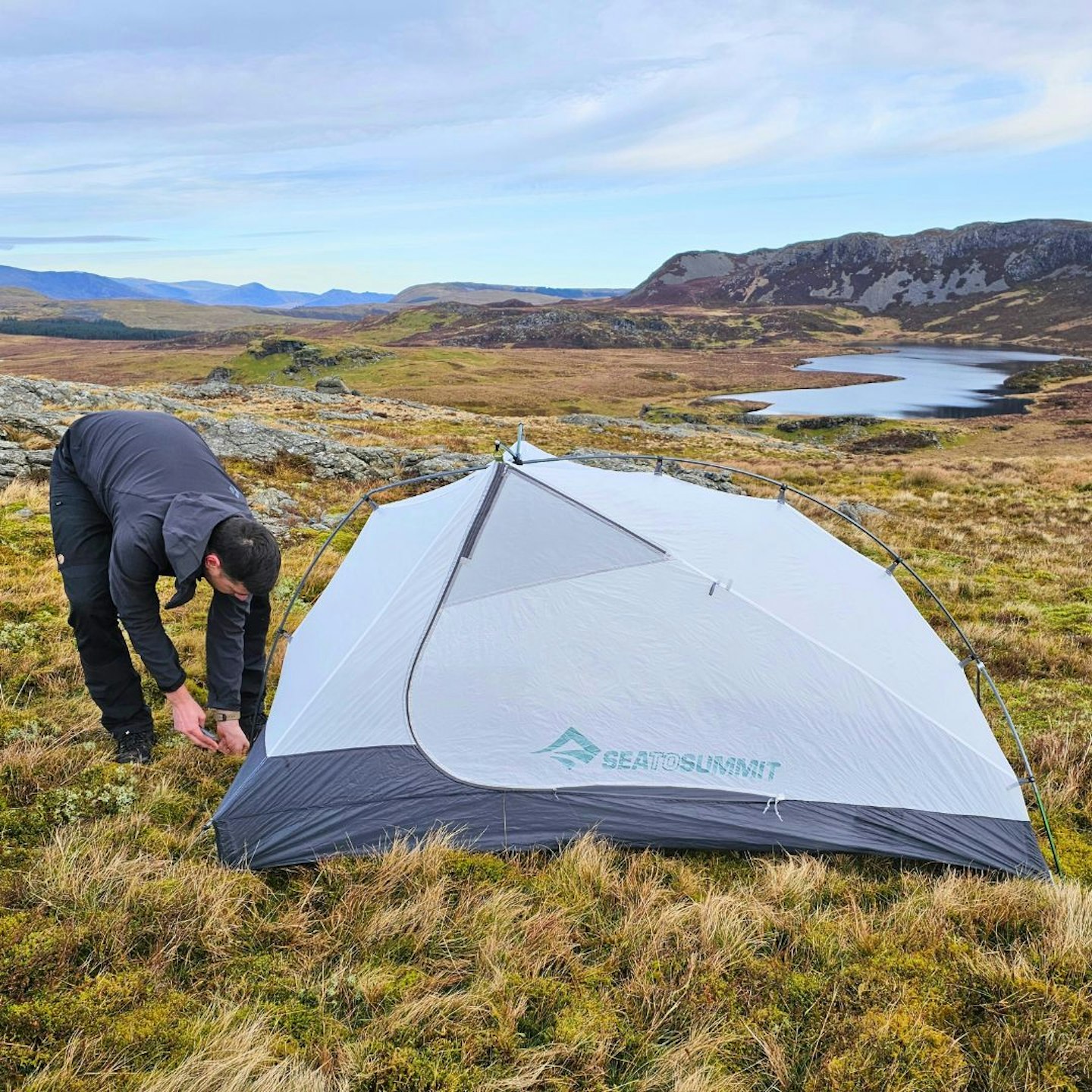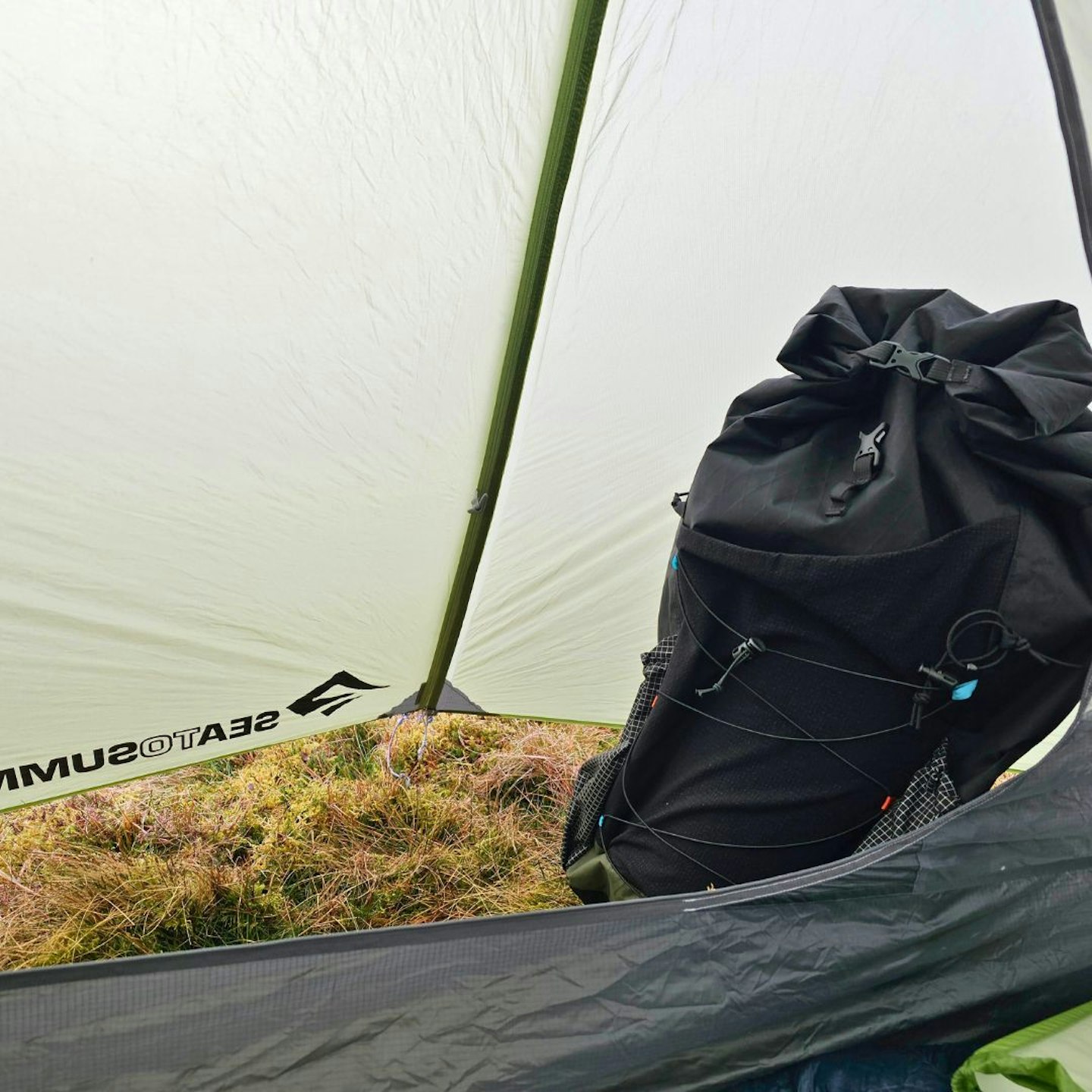The form of tents may differ today to those of 30,000 B.C. made from foliage or animal hides. But the function doesn't: protection from the elements.
Using the hides of mammoths to make tents isn't possible today. Even if it was, it would be an unpopular move. So we use synthetic materials for our lightweight tents instead. In this guide, we're looking at the best tents for hiking and camping. These, plus a couple of other popular options like roof tents.
Getting the right tent is all about picking one that conforms to your needs. There's such a vast array of tent designs that there will always be something for you. Of course, price is one factor, but you also need to consider shape, size, materials, sustainability, and weather resistance to name just a few.
What are the best tents of 2025?

What we've done here is go through a collection of popular categories of tents, from family tents to 3-person tents to bivvy bags, recommending the best of each. We've also included some buying advice too.
Best overall tent: MSR Tindheim 2
Best backpacking tent: Sea To Summit Alto TR1 Plus
Best family tent: Robens Eagle Rock 6+2XP
Best 3/4-season tent: Wild Country Helm Compact 1
How we tested the camping best tents

Tents, like all the gear we test, are put to work in true real world conditions. Our tent testing tends to involve both individual use where we take a tent on a camping or backpacking trip, and a group test session where we have a tent pitched alongside rivals to compare them directly against one another.
Our testers are all hugely experienced campers in all its forms, from solo bivvy missions to big family camping holidays. The tents recommended here were tested by our magazine's Gear Editor, Ben Weeks who is a wild camping fanatic; James Forrest, who is a lightweight backpacking enthusiast; Matt Jones who is a long-distance backpacking champion; Editor Oli Reed who is our go-to family camping expert; and our Senior Writer Chris Williams who is a huge gear geek.
When testing, we assessed each tent’s weather resistance, including waterproofing (hydrostatic head ratings, seam sealing, and bathtub floors) and wind resistance. We also considered size and capacity, ensuring adequate sleeping and storage space for solo, couple, and family use.
Weight and portability were key for backpacking tents, while ease of setup – freestanding vs pegged, pole vs inflatable – was tested across all categories. Ventilation and condensation control played a big role in comfort, and we examined the durability of materials, from fabrics and poles to groundsheets.
Of course, we also rated each tent based on its additional features, such as porches, blackout tech, and multiple doors, all of which may not be strictly necessary for proper minimalist camping, but we consider them to be big pluses in the LFTO book – liveability is an underrated factor when picking the best camping tent.
The best tents reviewed:
The Tindheim 2 is MSR's first tunnel tent, and it hits bullseye on so many levels.
It's very spacious for a two-person hiking tent, both in the sleeping space and porch area, which makes it ideal for extending hiking and backpacking trips.
We liked its stable, weatherproof design that can cope with pretty stroppy weather. Another very useful feature in this regard is the Tindheim 2's ability to be pitched outer first, or all-in-one. Yet, it's suitable for most of the year, thanks to the inner, which has zipped panels that can either boost ventilation or prevent draughts.
The Tindheim 2 was such a crowd pleaser among our team, and as a result, earned a Gear of the Year award for 2024.
Read our full MSR Tindheim 2 review
Pros
- Very spacious two-person tent
- Easy to pitch
- Very well made
- Stable weatherproof design
- Inner-first pitching
Cons
- Not the lightest or most compact
| RRP | £440 |
| Weight | 3.2kg / 7lbs (stripped weight 2.48kg / 5.5lbs) |
| Packed size | 56 x 20cm |
| Doors | 1 |
| Vestibules | 1 |
| Inner | 68D taffeta polyester w/ 40D nylon micromesh |
| Fly | 68D PU-coated polyester (1500mm HH) |
| Groundsheet | 68D PU-coated taffeta polyester (3000mm HH) |
| Poles | 7000 Series aluminium |
| Type | Tunnel tent |
Vango is a byword for great value camping kit in the UK and its Apex Compact (available in one-, two-, and three-person variants) is our overall 'best value' tent pick.
Why? On test, it performed almost as well as many of its premium rivals while costing hundreds of pounds less. The shape it uses (the single hooped pole with small supports at each end) is a proven design for backpacking tents, providing good weather resistance while also being lightweight. Aiding the Apex Compact's weatherproofing are high hydrostatic head ratings for the materials.
Internal space is perfectly acceptable, although not as commodious as the semi-freestanding shaped tents from Sea To Summit, for example.
In terms of weight, at just over 2kg it's not the lightest of its kind but it's still light enough for backpacking, and certain components such as buckles and stitching don't feel as high a quality as higher priced rivals.
Read our full Vango Apex Compact 200 review
Pros
- Very affordable
- Proven design
- Stable structure
- Vango sells spares and offers repair service
Cons
- Not the roomiest
- Heavier than premium rivals
- Lower quality than more expensive rivals
| RRP | £145 |
| Weight | 2.2kg / 4.9lbs |
| Packed size | 30 x 20cm |
| Doors | 2 |
| Vestibules | 1.5 |
| Inner | Polyester |
| Fly | Recycled 70D Protex Eco (3000mm HH) |
| Groundsheet | 70D polyester (6000mm HH) |
| Poles | PowerLite 7001-T6 alloy |
| Type | Tunnel |
Like microtechnology, the science of lightweight backpacking tents continues to evolve at an astounding rate. The Alto TR1 Plus is all about maximising internal space without increasing weight or compromising stability. And it achieves this with flying colours.
Sea To Summit uses its Tension Ridge Architecture to provide a higher ceiling in the Alto TR1 Plus and other spatial benefits, like a large porch. Tensions Ridge Architecture uses a cross pole to widen the tent's peak to make the walls near-perpendicular.
Sea To Summit says this is a tent for cooler climates, and so suits a British summer perfectly. The fly provides quite good coverage, and the fabrics are highly breathable to help reduce condensation on humid British nights. We've tested the Alto TR2 Plus as well and recommend it just as highly.
The waterproof ratings on Alto TR1 Plus are what a geography teacher would describe as satisfactory. It's quite a pricey tent too and isn't PFC-free. But for all the clever design that goes into it, you soon realise its worth.
Read our full Sea To Summit Alto TR1 Plus review
Pros
- Very lightweight and compact
- Ample headroom
- Breathable fabric
- 2-person version available
Cons
- Waterproof ratings could be better
| RRP | £490 |
| Capacity | 1 person |
| Weight | 1.23kg / 2.7lbs |
| Doors | 1 |
| Inner | 20D Sil-PeU nylon ripstop |
| Fly | 15D Sil-PeU coated nylon ripstop, 1200mm HH |
| Groundsheet | 20D Sil-PeU coated nylon ripstop, 2500mm HH |
| Poles | DAC Featherlite NFL 8.7mm, PF 9.5mm, and 9.8mm anodised aluminium |
| Packed size | 44 x 11cm |
| Type | Semi-freestanding |
Jack Wolfskin's Eclipse III impressed us in terms of its versatility and sustainability. For camping and hiking, there are few tents as good at both as the Eclipse III.
What makes the Eclipse III so good for camping is its plentiful interior space and excellent waterproofing. Meanwhile, while it's not the lightest tent of this type, it does still pack down reasonably well and can therefore be carried in a large comfortable pack if required. Though, you'll certainly want a lighter option for long distance treks.
Regarding sustainability, the Eclipse III is made mostly from recycled material and is PFC-free. You also have a clearer conscience at the manufacturing end too, because Jack Wolfskin is also a Fair Wear Foundation member with ‘Leader’ status.
Read our full Jack Wolfskin Eclipse III review
Pros
- Versatile for hiking and camping
- Sustainable
- Very good weather protection
Cons
- Not the lightest tent of this type
| RRP | £320 |
| Weight | 5.2kg / 12lbs |
| Packed size | 54 x 22cm |
| Doors | 2 |
| Vestibules | 2 |
| Inner | 68D polyester |
| Fly | 75D polyester (4,000mm HH) |
| Groundsheet | 150D polyester (10,000mm HH) |
| Poles | Fibreglass |
| Type | Freestanding dome |
Big, spacious family tents are a very far cry from their compact colleagues and the market is also just as competitive. Robens' Eagle Rock 6+2XP takes the prize for us in this category due to its fantastic build quality, liveability, and style.
The price is premium but we don't think this tent to suffer from the law of diminishing returns. We feel it's completely justified, in fact, if you're after a fantastic family tent.
From the aluminium poles to the door toggles, it's all just so well made. We also rate the green and beige colours scheme. It makes the Eagle Rock 6+2XP blend nicely into the landscape on any campsite.
The porch area is large, the features are plentiful and there are two large entrances. Its living space is generous in both floor space and headroom.
Read our full Robens Eagle Rock 6+2XP review
Pros
- Very spacious
- Handy separate bedroom
- Great quality materials
- Feels very durable
Cons
- Takes up a lot of boot space
| RRP | £1330 / $1364.95 |
| Capacity | 6 |
| Weight | 23.6kg / 52lbs |
| Doors | 3 |
| Inner | 68D Polyester 185T, breathable polyester |
| Fly | HydroTex HD 75D polyester Taffeta 185T PU coated (5,000mm HH) |
| Groundsheet | Polyethylene (10,000mm HH) |
| Poles | 6061 aluminium 8.5, 9.5, and 16mm |
| Packed size | 78 x 42cm |
| Type | Tunnel |
Introducing the Wild Country Helm Compact 1 tent, venerated former winner of the tent category of our Gear of the Year awards. This is an affordable yet impressive choice for any would-be wild campers who don't want to break the bank this year. It performs exceptionally well and packs up nice and small.
This freestanding dome tent is not only well-proportioned but also remarkably durable. We've witnessed the Helm Compact 1 endure severely harsh winter conditions. Remarkably, it matched the performance of much pricier alternatives pretty much blow-for-blow.
The only kicker is, due to its popularity, finding one can be challenging. But don't lose hope! Persistence pays off. Keep your eyes peeled for this nicely portable piece which weighs in at sub-2kg. Not exactly ultralight, but perfectly serviceable in our book.
Read our full Wild Country Helm Compact 1 review
Pros
- Incredible price
- Small pack-size
- Reliably durable
Cons
- Patchy availablility
| RRP | £250 |
| Capacity | 1 person |
| Weight | 1.97kg / 4.3lbs |
| Doors | 1 |
| Inner | 68D polyester Ripstop |
| Fly | Stormtex 68D polyester Ripstop PU 4000mm HH |
| Groundsheet | Aqua Stop 68D PU 5000mm HH |
| Poles | 8.5mm WC Superflex Alloy |
| Packed size | 35 x 17cm |
| Type | Dome |
To give this tent a proper test, we took it to the Isle of Skye for some wild camping in June. Unusually for Scotland, the weather was subdued and sunny. But luckily, it also involved a rainy night in the Lake District on the way up.
Apart from being quite snug for two people, the Zephyros Compact (compact, indeed) 2 is an excellent and versatile tent for 3-season use in the UK. It has very good waterproof ratings and is pitched in just a few minutes. It's a simple three-pole setup with a single arching pole in the middle and a small one at each end.
It might not look it, but the Zephyros Compact 2 is very stable and weather resistant. It's every bit the 3-season tent Terra Nova says it is. The primary complaint from us is the small porch area. It's okay for one person's gear but is inadequate for two.
Read our full Wild Country Zephyros Compact 2 tent review
Pros
- Lightweight
- Good waterproof ratings
- Easy to pitch
Cons
- Very snug for 2 people
- Small porch
| RRP | £260 |
| Capacity | 2 person |
| Weight | 1.95kg / 4.3lbs |
| Doors | 2 |
| Inner | 68D polyester ripstop |
| Fly | Stormtex 68D polyester ripstop PU, 4000mm HH |
| Groundsheet | Aqua Stop 68D PU, 5000mm HH |
| Poles | WC Superflex alloy 8.5mm and WC Superflex alloy 8mm |
| Packed size | 30 x 16cm |
| Type | Tunnel |
The appeal of a bivvy relies on being lighter and more compact than a tent. Over the years, some solo tents have got lighter, and some bivvies (especially those that use a hooped pole) have become more bulky. And they have almost met in the middle.
Luckily, Outdoor Research has maintained the low weight/packed size edge that bivvies have over tents with the Helium, which has become our benchmark bivvy bag.
At under 500g, it's a very lightweight shelter. Granted, it's not the very lightest bivvy you can get but the Helium offers very good weather protection too, which means you can use it most of the year round.
The hooped pole drastically improves liveability and reduces a feeling of claustrophobia compared to bivvy bags without a pole.
Read our full Outdoor Research Helium Bivy review
Pros
- Protective
- Versatile
- Lightweight for hooped design
- Better waterproofing and breathability than most rivals
- Surprisingly durable
Cons
- Not as roomy as some rivals
- Some rivals have superior eco credentials
| RRP | $225 |
| Weight | 494g / 17.4oz |
| Dimensions | 208 x 66cm (shoulder)/48cm (foot) |
| Main material | Bluesign-approved 30D nylon 2.5-layer Pertex Shield Diamond Fuse (40D nylon floor) |
| Waterproof rating | 20,000mm HH |
| Breathability rating | 20,000g/m²/24 hour |
| Packed size | 31 x 9cm |
The TentBox Classic 2.0 stands out here like a hiker wearing blazing red hiking jacket on a snowy mountainside. But the Classic 2.0 can be a good tent option for hikers. Perhaps you're the type that prefers fast-paced day hikes, for example. With a roof tent on your car, you can bounce around the country, conquering summits, covering ground quickly.
The roof tent provides the sleeping comfort of a campervan but the tenting experience. The TentBox Classic 2.0 is the best among a growing choice of roof tents. One of the key factors is its hardshell design. Not only does it look better, it's more protective and aerodynamic than those that use a heavy-duty soft cover.
Adding to the convenience is the fact you can collapse the Classic 2.0 with your sleeping gear still in it. So it really is setup at your overnight stop in seconds. Among the neat accessories for the Classic, an insulated inner makes the Classic 2.0 suitable for winter trips too.
No doubt the TentBox Classic 2.0 is expensive, but if it suits your travel and hiking style, its returns are healthy.
Pros
- Super fast to set up
- Hardy and aerodynamic hardshell
- Lots of clever design touches
Cons
- No skylights
| RRP | £2,195 / $2,795 |
| Weight | 65kg / 143lbs |
| Capacity | 2 person |
| Doors | 2 |
| Main fabric | 280gsm rip-stop canvas walls, 2000mm HH |
| Hardshell | ABS with UV protective treatment |
| Frame | Aluminium with stainless steel hinges and fixings |
| Packed size | 210 x 128 x 35cm |
| Type | Roof tent |
How to choose the best tent for you

What tent shape is best?
Dome and geodesic tents have good stability and strength – geodesic tents are the best for winter, but these types tend to be heavier and less spacious than other shapes.
Tripod or backpacking-style tents (like in the photo above) are often the lightest and most compact type of tent you can get for going to a bivvy or tarp. They are most commonly for one person or pairs.
Tunnel tents provide the best ratio of space and weight. They can be quite stable too, if using stronger poles, more guy lines, and aren't tall. There are tunnel tents for every season and use, from family camping to backpacking and mountain treks.

Beyond this, you have other tent types such as roof tents and teepee-style tents. Roof tents are the easiest of all to pitch and are extremely comfy to sleep in because they have a proper mattress and feel more like a bedroom. They are quite pricey, though. Bell/teepee-style tents are associated with glamping and their raised ceilings and often canvas construction make for superb liveability. But they usually only have one space rather than separate rooms.
What are the best materials for a tent?
Polyester and nylon are the two most common materials used to make tents these days. Polyester is inexpensive and doesn't sag when wet. Nylon is lightweight and strong. Some tents use a canvas-type material (usually poly-cotton), which is heavy but very durable and breathable.

When it comes to polyester and nylon materials, check the denier rating of the fabrics too. A denier rating (e.g., 15D) indicates the thickness of the fibres of the tent fabric. It's a good indicator of fabric strength, but predictably adds weight.
In terms of waterproofing, this is an area that contains a lot of acronyms and unfamiliar terms. As a rule, silicone-coated outer fabrics are stronger and lighter than polyurethane (PU)-coated ones, but more expensive.
What do waterproof ratings mean?
Waterproof ratings (hydrostatic head, or HH) are another important aspect. The figure refers to how much water pressure the fabric can withstand (e.g., 3000mm HH = 3-metre column of water pressure). The higher the figure, the more waterproof a fabric is, but weight often climbs with it because more coating is needed.
Seam sealing is important to waterproofing too. A common tactic is taped seams, but the taping can wear away over the years. Some brands are coming up with alternatives, so have a look into these.

Space and liveability
In the same way, you need to ensure there is enough sleeping space, you also need to check how much storage space a tent has for your gear. This includes vestibules and storage pockets.
If there will be at least two of you in the tent, having a door on each side is always handy. And two-door tents often have two vestibules, which increases storage space.
For family tents, space and liveability are vital. Large tents have a few different layouts, so do some research and visit some camping stores to see what suits your needs best. Also consider aspects such as light, ventilation, and privacy.

Weight and packed size
We want our hiking tents to be as light as possible, but there needs to be a balance. If we're 3-season or winter campers, durability and weather resistance are equally important. For all, the right internal space is crucial too.
Some tents have a separate stuff sack for the inner, fly, and groundsheet to help distribute the weight among hikers. But 1-1.5kg backpacking tents and bivvy bags are approaching the size of a Subway sandwich when packed down and therefore aren't such a burden.
Larger family tents are always going to be moderately bulky, but as these get transported in the car this isn't such an issue, so long as there's space left for all your other camping gear.
Additional features
Beyond the basics, a few key extras can make all the difference in your camping experience. A decent porch or vestibule is invaluable for keeping wet gear out of your sleeping space and providing extra storage.
Some tents now come with blackout technology, which blocks out early morning sunlight—ideal if you're not keen on waking up at dawn. Multiple doors are another handy feature, especially for larger tents, as they make getting in and out easier without clambering over your tent mate in the middle of the night.
Does your tent match your budget?
Tents range wildly in price, from budget-friendly options under £100 to high-end models costing over £400. At the lower end, expect simple designs, lightweight materials, and fewer features—great for occasional camping or festivals.
Mid-range tents (£150-£400) tend to strike the best balance between durability, weather protection, and features, making them the sweet spot for most campers. If you're after premium materials, top-tier weatherproofing, or a tent designed for extreme conditions, high-end models justify their price with long-lasting performance and cutting-edge design.
How to clean a tent
This is a really simple but also very important step. Tents need to be cleaned properly after each decent use to maintain fabric breathability, waterproofing, and overall condition. UV rays and abrasive dirt wears away at tent fabrics and can cause them to be less effective.
If your tent does start to leak, there are things you can do to solve that. See our guide on how to waterproof a tent for more.
Products such as Grangers Kit and Nikwax Camping Care Kit (below) are ideal for tent fabric care.
Contains Grangers Tent and Gear Cleaner and Repel. The former cleans the fabric, the latter applies durable water repellency. Can be used for tents and other gear such as packs.
Pros
- PFC-free
- Water-based
- Very effective
Cons
- Nikwax Camping Care Kit is better value
This kit comes with Nikwax's tent and gear wash and reproofing sprays, plus microfibre cloths and a 10-litre dry bag. Can be used on tents and packs.
Pros
- PFC-free
- Water-based
- Dry bag included
Cons
- We prefer tent wash as a concentrate (like Grangers)
About the author

Chris Williams is LFTO's Senior Writer. He has extensive knowledge of tents and camping, having used the portable shelters all his life from everything from family camping in summer to ardous mountain missions.




























